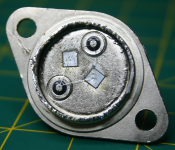[FONT=Times New Roman, serif]Michael, you wrote a lot about finding the sweet spot in your article. And there is a significant note:[/FONT]
„[FONT=Times New Roman, serif]Hopefully, this little thought experiment has helped you to understand what happens when we[/FONT][FONT=Times New Roman, serif] vary certain parameters in search of the sweet spot. I’d like to point out however, that finding the sweet spot on paper is really only useful as a rough starting point. In real life, speakers aren’t resistors (the speaker's actual load line is elliptical), and gain devices never look exactly like the datasheet.”[/FONT]
[FONT=Times New Roman, serif]So resistive load is probably most loved by amplifiers from distortion figures point of view. (More about that can be found in article „Heavy Load: How Loudspeakers Torture Amplifiers b[/FONT]y Keith Howard Heavy Load: How Loudspeakers Torture Amplifiers | Stereophile.com) [FONT=Times New Roman, serif]As a matter of fact speaker impedance change with frequency, sometimes very significantly. On the other hand effective wideband drivers are the best for SIT amp and they suffer from this fenomena to. In other words the SIT amp sweet spot is dependant on real speaker impedance which in turn is dependant on frequency not nominal one. So sweet spot should match particular speaker then. Should we go to the great lengths in leveling speaker impedance curve to get best sound ?[/FONT]
„[FONT=Times New Roman, serif]Hopefully, this little thought experiment has helped you to understand what happens when we[/FONT][FONT=Times New Roman, serif] vary certain parameters in search of the sweet spot. I’d like to point out however, that finding the sweet spot on paper is really only useful as a rough starting point. In real life, speakers aren’t resistors (the speaker's actual load line is elliptical), and gain devices never look exactly like the datasheet.”[/FONT]
[FONT=Times New Roman, serif]So resistive load is probably most loved by amplifiers from distortion figures point of view. (More about that can be found in article „Heavy Load: How Loudspeakers Torture Amplifiers b[/FONT]y Keith Howard Heavy Load: How Loudspeakers Torture Amplifiers | Stereophile.com) [FONT=Times New Roman, serif]As a matter of fact speaker impedance change with frequency, sometimes very significantly. On the other hand effective wideband drivers are the best for SIT amp and they suffer from this fenomena to. In other words the SIT amp sweet spot is dependant on real speaker impedance which in turn is dependant on frequency not nominal one. So sweet spot should match particular speaker then. Should we go to the great lengths in leveling speaker impedance curve to get best sound ?[/FONT]
Should we go to the great lengths in leveling speaker impedance curve to get best sound ?
Like a Zobel network or other filter?
or , as already written oomphteen times - send boom to woof via elko (still bypassed with nice cap) and send shhhh to squawker via adequately sized small solid cap
that demands two pairs of terminals per channel ....
in case of feeding just FR , proceed simple as usual

so with my avantgarde horn ( mid / high speaker) going down to 300hz i can use a big 600uf film cap in place of the 10000uf electrolyte ? don't know if it will change the sound but funny to try
Back from the gulf. No turtles, but I got to swim among a large school of "devil" manta rays.
Here's an opened 2SK82. 2 x 4mm dies. $25 for science.
Michael,
Just for my information, is there a reason you can't still use the 2SK82? Is it sealed from oxygen like a tube or something? Or just sealed to keep the delicate wires from damage?
I bet if you could hook it up it would sound more "Open"
Also, is the 2SK60 only one 4mm die?
Rush
Michael,
I bet if you could hook it up it would sound more "Open"
Rush
Yesss, a really good suggestion for more open sound: Cut the caps!
Back from the gulf. No turtles, but I got to swim among a large school of "devil" manta rays.
Here's an opened 2SK82. 2 x 4mm dies. $25 for science.
Nice picture, so then we have 2x 2sk60 in parallel.
We have two chips in parallel. What they are remains to be proven.
I do not have any physical samples of 2SK60, and the curves I have for them wouldn't quite make a 2SK82 (with two in parallel) although I'd place it in the realm of possibility at least, since they are somewhat close and I have no way of knowing how good my 2SK60 curves really are.
I do not have any physical samples of 2SK60, and the curves I have for them wouldn't quite make a 2SK82 (with two in parallel) although I'd place it in the realm of possibility at least, since they are somewhat close and I have no way of knowing how good my 2SK60 curves really are.
Last edited:
Michael,
Just for my information, is there a reason you can't still use the 2SK82?
The TO-3 package is hermetically sealed, so I assume sawing it open has rendered it a museum piece.
It will be easier to measure the junction temp
I have this nagging feeling that naked is the new standard.
Rush
a SITamp 3 is comming? tell us more my friend
Oh sorry juanitox, I did nit mean any SIT amps, but the infrared camera related homepage that was recommended by vdi_nenna to Mike R......
- Home
- Amplifiers
- Pass Labs
- L'Amp: A simple SIT Amp


